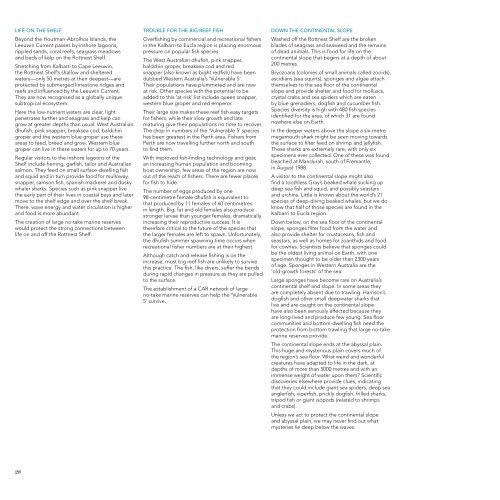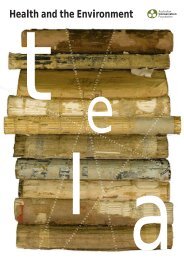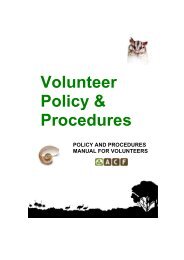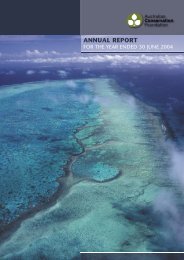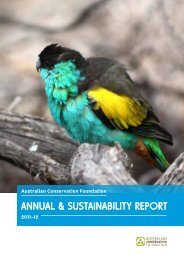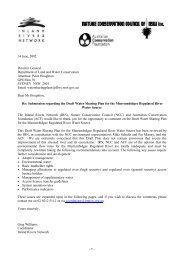Protecting Western Australia's Big Blue Backyard - The Pew ...
Protecting Western Australia's Big Blue Backyard - The Pew ...
Protecting Western Australia's Big Blue Backyard - The Pew ...
- No tags were found...
Create successful ePaper yourself
Turn your PDF publications into a flip-book with our unique Google optimized e-Paper software.
LIFE ON THE SHELFBeyond the Houtman-Abrolhos Islands, theLeeuwin Current passes by inshore lagoons,rippled sands, coral reefs, seagrass meadowsand beds of kelp on the Rottnest Shelf.Stretching from Kalbarri to Cape Leeuwin,the Rottnest Shelf’s shallow and shelteredwaters—only 50 metres at their deepest—areprotected by submerged limestone ridges andreefs and influenced by the Leeuwin Current.<strong>The</strong>y are now recognised as a globally uniquesubtropical ecosystem.Here the low-nutrient waters are clear, lightpenetrates further and seagrass and kelp cangrow at greater depths than usual. West Australiandhufish, pink snapper, breaksea cod, baldchingroper and the western blue groper use theseareas to feed, breed and grow. <strong>Western</strong> bluegroper can live in these waters for up to 70 years.Regular visitors to the inshore lagoons of theShelf include herring, garfish, tailor and Australiansalmon. <strong>The</strong>y feed on small surface-dwelling fishand squid and in turn provide food for mulloway,snapper, samson fish, spanish mackerel and duskywhaler sharks. Species such as pink snapper livethe early part of their lives in coastal bays and latermove to the shelf edge and over the shelf break.<strong>The</strong>re, wave energy and water circulation is higherand food is more abundant.<strong>The</strong> creation of large no-take marine reserveswould protect the strong connections betweenlife on and off the Rottnest Shelf.TROUBLE FOR THE BIG REEF FISHOverfishing by commercial and recreational fishersin the Kalbarri to Eucla region is placing enormouspressure on popular fish species.<strong>The</strong> West Australian dhufish, pink snapper,baldchin groper, breaksea cod and redsnapper (also known as bight redfish) have beendubbed <strong>Western</strong> Australia’s ‘Vulnerable 5’.<strong>The</strong>ir populations have plummeted and are nowat risk. Other species with the potential to beadded to this ‘at-risk’ list include queen snapper,western blue groper and red emperor.<strong>The</strong>ir large size makes these reef fish easy targetsfor fishers, while their slow growth and latematuring give their populations no time to recover.<strong>The</strong> drop in numbers of the ‘Vulnerable 5’ specieshas been greatest in the Perth area. Fishers fromPerth are now travelling further north and southto find them.With improved fish-finding technology and gear,an increasing human population and boomingboat ownership, few areas of the region are nowout of the reach of fishers. <strong>The</strong>re are fewer placesfor fish to hide.<strong>The</strong> number of eggs produced by one98-centimetre female dhufish is equivalent tothat produced by 11 females of 60 centimetresin length. <strong>Big</strong>, fat and old females also producestronger larvae than younger females, dramaticallyincreasing their reproductive success. It istherefore critical to the future of the species thatthe larger females are left to spawn. Unfortunately,the dhufish summer spawning time occurs whenrecreational fisher numbers are at their highest.Although catch and release fishing is on theincrease, most big reef fish are unlikely to survivethis practice. <strong>The</strong> fish, like divers, suffer the bendsduring rapid changes in pressure as they are pulledto the surface.<strong>The</strong> establishment of a CAR network of largeno-take marine reserves can help the ‘Vulnerable5’ survive.DOWN THE CONTINENTAL SLOPEWashed off the Rottnest Shelf are the brokenblades of seagrass and seaweed and the remainsof dead animals. This is food for life on thecontinental slope that begins at a depth of about200 metres.Bryozoans (colonies of small animals called zooids),ascidians (sea squirts), sponges and algae attachthemselves to the sea floor of the continentalslope and provide shelter and food for molluscs,crystal crabs and sea spiders which are eatenby blue grenadiers, dogfish and cucumber fish.Species diversity is high with 480 fish speciesidentified for the area, of which 31 are foundnowhere else on Earth.In the deeper waters above the slope a six-metremegamouth shark might be seen moving towardsthe surface to filter feed on shrimp and jellyfish.<strong>The</strong>se sharks are extremely rare, with only sixspecimens ever collected. One of these was foundbeached at Mandurah, south of Fremantle,in August 1988.A visitor to the continental slope might alsofind a toothless Gray’s beaked whale sucking updeep sea fish and squid, and possibly seastarsand urchins. Little is known about the world’s 21species of deep-diving beaked whales, but we doknow that half of those species are found in theKalbarri to Eucla region.Down below, on the sea floor of the continentalslope, sponges filter food from the water andalso provide shelter for crustaceans, fish andseastars, as well as homes for zoanthids and foodfor cowries. Scientists believe that sponges couldbe the oldest living animal on Earth, with onespecimen thought to be older than 2300 yearsof age. Sponges in <strong>Western</strong> Australia are the‘old-growth forests’ of the sea.Large sponges have become rare on Australia’scontinental shelf and slope. In some areas theyare completely absent due to trawling. Harrison’sdogfish and other small deepwater sharks thatlive and are caught on the continental slopehave also been seriously affected because theyare long-lived and produce few young. Sea floorcommunities and bottom-dwelling fish need theprotection from bottom trawling that large no-takemarine reserves provide.<strong>The</strong> endemic West Australiandhufish is one of a number of bigreef fish species under threat fromoverfishing by commercial andrecreational fishers© Glen Cowans<strong>The</strong> continental slope ends at the abyssal plain.This huge and mysterious plain covers much ofthe region’s sea floor. What weird and wonderfulcreatures have adapted to life in the dark, atdepths of more than 5000 metres and with animmense weight of water upon them? Scientificdiscoveries elsewhere provide clues, indicatingthat they could include giant sea spiders, deep seaanglerfish, viperfish, prickly dogfish, frilled sharks,tripod fish or giant isopods (related to shrimpsand crabs).Unless we act to protect the continental slopeand abyssal plain, we may never find out whatmysteries lie deep below the waves.28


